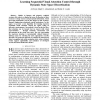Free Online Productivity Tools
i2Speak
i2Symbol
i2OCR
iTex2Img
iWeb2Print
iWeb2Shot
i2Type
iPdf2Split
iPdf2Merge
i2Bopomofo
i2Arabic
i2Style
i2Image
i2PDF
iLatex2Rtf
Sci2ools
ICRA
2009
IEEE
2009
IEEE
Learning sequential visual attention control through dynamic state space discretization
² Similar to humans and primates, artificial creatures like robots are limited in terms of allocation of their resources to huge sensory and perceptual information. Serial processing mechanisms used in the design of such creatures demands engineering attentional control mechanisms. In this paper, we present a new algorithm for learning top-down sequential visual attention control for agents acting in interactive environments. Our method is based on the key idea, that attention can be learned best in concert with visual representations through automatic construction and discretization of the visual state space. The tree representing the top-down attention is incrementally refined whenever aliasing occurs by selecting the most appropriate saccadic direction. The proposed approach is evaluated on action-based object recognition and urban navigation tasks, where obtained results support applicability and usefulness of developed saccade movement method for robotics.
Creatures Demands Engineering | ICRA 2009 | Robotics | Sequential Visual Attention | Serial Processing Mechanisms |
| Added | 23 May 2010 |
| Updated | 23 May 2010 |
| Type | Conference |
| Year | 2009 |
| Where | ICRA |
| Authors | Ali Borji, Majid Nili Ahmadabadi, Babak Nadjar Araabi |
Comments (0)

